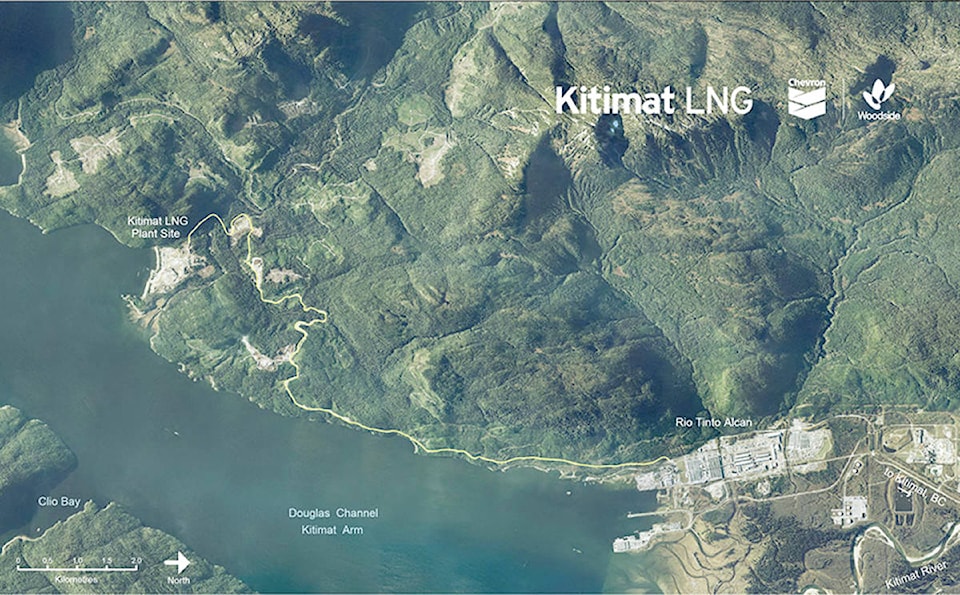Kitimat LNG says its application to the federal government’s National Energy Board to double its liquefied natural gas export licence is the result of a radical redesign of the proposed natural gas processing facility in Kitimat.
The application, submitted at the beginning of April, was made nine months before the expiry of Kitimat LNG’s initial licence to export LNG that was issued in 2011.
As part of the application, Kitimat LNG joint partners Chevron and Woodside also applied to extend the initial LNG export period of 20 years contained in its initial export licence, to 40 years.
https://www.northernsentinel.com/news/australian-company-woodside-ends-grassy-point-lng-project/
Chevron Canada communications team lead Leif Sollid said a redesign of the facility was commissioned in 2015 with the focus on improving Kitimat LNG’s cost-of-supply competitiveness relative to other global LNG projects.
“As a result, Chevron and Woodside have revised the Kitimat LNG plant design to one that may include up to three LNG trains and deliver up to 18 MTPA of LNG. The new licence application reflects this new project design,” said Sollid.
The project’s current export licence will expire on December 31, necessitating Chevron and Woodside apply for a new export licence.
“Since 2015, Chevron and Woodside have made significant progress in enhancing KLNG competitiveness, reducing LNG unit costs by over 45 per cent and incorporating a new all-electric LNG plant design,” said Sollid.
“KLNG has a new LNG plant design consisting of a two-train, 12-MTPA foundation project with potential for a third train, 6-MTPA expansion, which would be powered by clean, renewable hydroelectricity from BC Hydro.”
He said the new plant design also features an advanced, compact module design enabling low-cost operations, high efficiency and high availability.
The Kitimat LNG project will see natural gas piped to Kitimat along the Pacific Trail Pipeline from sources in the Liard and Horn River basins in northeastern B.C.
In Kitimat, the natural gas will be processed and shipped from the facility at Bish Cove, located outside Kitimat down the Douglas Channel.
Reacting to concerns about sufficient supply of natural gas, former NEB chairman Roland Priddle wrote in a report that accompanied Kitimat LNG’s application to the NEB, Riddle said doubling the facility’s output from 10 to 20 MTPA would not compromise existing supplies of natural gas.
“The trends in the discovery of gas have been and look to be favourable. The gas resource base in Canada, as well as North America, is very large in relation to requirements even when requirements are generously reckoned,” says Riddle in his report to the regulator.
“The limitation on gas supply will continue to be the availability of economic markets available to Canadian gas producers. Chevron’s exports constitute one of those markets.”
Sollid wouldn’t be drawn on a date for the Final Investment Decision (FID), or on the overall cost of the project.
However, in their application to the NEB, the partners state the commissioning of the Kitimat terminal “is anticipated to be no later than 2029 depending on the pace of regulatory approvals and a final investment decision by the project’s sponsors.
https://www.northernsentinel.com/local-news/adverts-not-an-indication-of-progress-on-pipeline-lng/
“Timing could be influenced by a number of project variables, including project economics,” reads the application documentation.
“A final investment decision for KLNG will be driven by LNG market demand and sales agreements, project competitiveness, a clear, stable and competitive fiscal framework with the B.C. and federal governments and continued support for the project with local First Nations and communities.”
Sollid said Kitimat LNG is still engaged in activities along the total length of the project, including pipeline right-of-way maintenance and compliance work associated with existing environmental permits along the proposed PTP route.
However, the project retains federal and provincial environmental approvals, a terminal site lease and benefits agreement with the Kitimat native community.
In chemical or petrochemical processes a “train” is comprised by a series of steps in a process.
A train consists of a progression of processes and their related equipment arranged in a series of steps that generally begin with a feedstock and resulting in a final product.
The term train is used to describe the linear relationship of the process steps involved which are usually interconnected by piping or other material transport modes.
